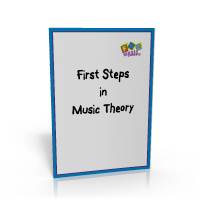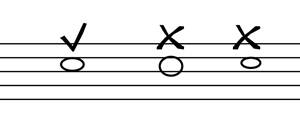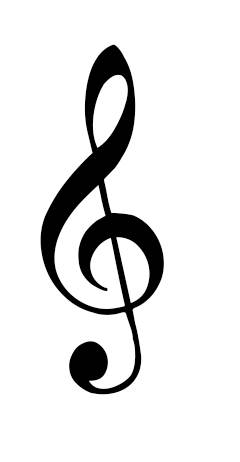First Steps in Music Theory
Congratulations on your desire to learn more about music theory!

Music theory is the language of music. It is the basis of how musicians communicate with each other, and record their craft.
It has evolved over hundreds of years, so it has a bit of mystery and can seem very daunting to beginners, when faced with pages full of complicated notation and difficult concepts to master.
Is it any wonder that a lot of musicians simply say “I can’t read music” and leave it at that. They learn to play by ear, and never really master the art of music theory, and sometimes have trouble communicating their music to others, or recording it on paper.
A knowledge of music theory also brings with it an increased desire to compose and write songs, as you become aware of all the tools that are available to you.
I don’t know how you found this page – whether you are a person who wants to just learn a little bit more about this subject, or whether you’re a musician who has never been able to read music, or if you’re a parent helping a child. However you found it, and whoever you are, you are very welcome to enjoy this material and I hope you’ll find it helpful.
This article is intended to just give you some absolute fundamentals, and some worksheets to help you consolidate your skills.
You cannot learn music theory just by reading. If you just read through this article, then you’ll be effectively wasting your time. You need to DO things as you go along. That is why we’ve provided printable worksheets for each topic we cover in this course.
As you read through each topic, then print the worksheet, and complete it then and there before you go onto the next topic.
PLEASE DO THIS! It will really assist you to actually KNOW the material, not just intellectually, but actually be able to use it in practice.
Quick note: This tutorial and associated materials for download uses American terminology. This doesn’t mean that users in the rest of the world can’t use it, it just means that we’ve chosen to go with this terminology for the purposes of these tutorials. There are only minor differences in only a few words anyway, but we thought it was important to note at this time. All our full products at the Fun Music Company offer a choice of language styles, but to keep it easier for readers we kept these tutorials to the American system.
Anyway, enough of that, lets get into the lesson:
Topic #1: The Staff
Today we’re starting at the very beginning… and looking at the most fundamental thing in music theory: the lines it is written on.
Music is placed on five lines, called the Staff.
Music notes are placed either on the lines:
Or in the spaces:
Music notes are not round, they are actually shaped like an oval on its side.
Accuracy is extremely important in music theory, as a badly placed note can be mis-read by another musician as on a different line or space.
When drawing a note on a line, their centre goes right through the middle of the line, and no more than half the way through the space above and the space below:
Space notes need to touch the lines above and below, but not go over them:
At the end of each of these topics is a worksheet. Please stop here and do the following things before you read any further:
1) click the icon below and download this worksheet
2) Print it out
3) Get yourself a sharp pencil
4) Complete the worksheet as neatly as you can.
You might think to yourself…..”Why should I do that? This seems completely obvious”
You can only learn music theory by doing it. You can’t learn this subject just by reading articles on the internet. Sure, you might pick up a few things, but there won’t be a major shift in your experience.
Do yourself a favour, and do this right now. It’ll only take a few minutes, then you can proceed with topic #2
Topic #2 – The Treble Clef
Did you do the first worksheet yet?
If not, please don’t proceed any further until you’ve done it! It really will make a drastic difference to your outcome of being able to read and understand music if you follow through and do the worksheets as we do them. You’ll get answers at the end, so you can check your work.
The subject today is the Treble Clef
A clef is the curly symbol that appears on the music lines at the start of a piece of music.
The treble clef (if you use some imagination) began as a stylised letter ‘g’ and its purpose really is to tell you where ‘g’ is located on the staff.
It is written so it curls snd scrolls around the second line up. This is the line where G is located. It continues as follows:
Topic #3: The Bass Clef
When lower notes are played, the bass clef is used.
It touches the top of the five line staff, and most importantly the two dots are placed either side of the second line.
It is also called the ‘F’ Clef because it defines where F is on the staff
To draw it, start with a dot on the F line, then curve up and touxh the top line, then curve downward, finishing on or just under the fourth line.
The dots must go on each side of the F line, in the top two spaces of the staff.
So, what have we learned so far?
- Music is placed on sets of five lines, which are called the staff.
- Notes are placed on the lines or in the spaces on the staff
- Clefs determine what lines represent what notes
- The treble clef is the most common clef, which is used for more treble (or higher pitched) instruments.
- The treble clef determines that the second line up denotes the note ‘G’
- The bass clef is for lower pitched instruments
- The bass clef determines that the second line down denotes the note ‘F’
So, print out the following worksheet, then pick up your pencil and complete the worksheet.
Done?
Now you can download the answers for the three worksheets you’ve just done, and check them.
They should be pretty straight forward, so you can give yourself a pat on the back and look forward to your next tutorial, which will be coming soon!
Combined set of Answered Worksheets for tutorial #1











